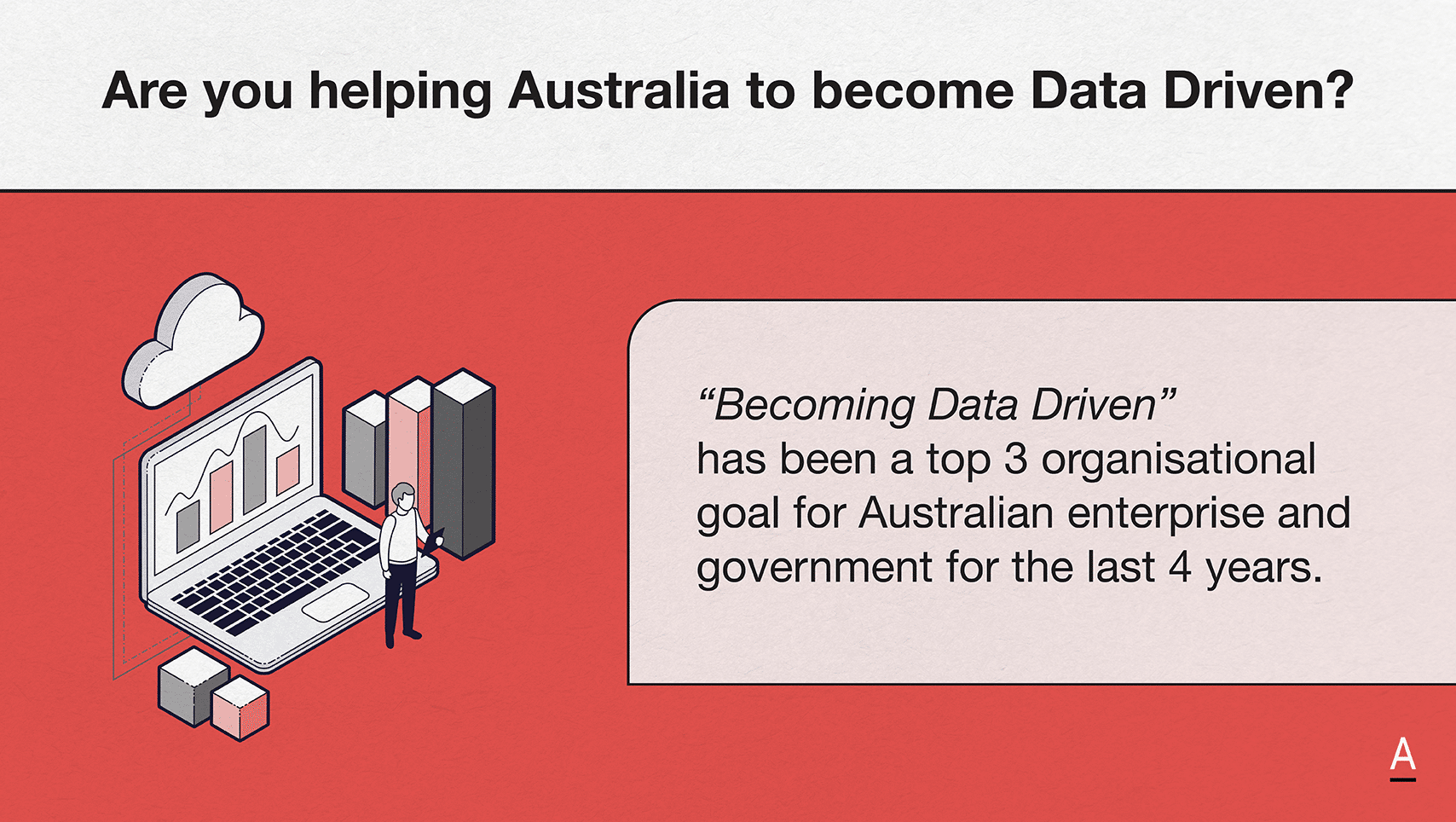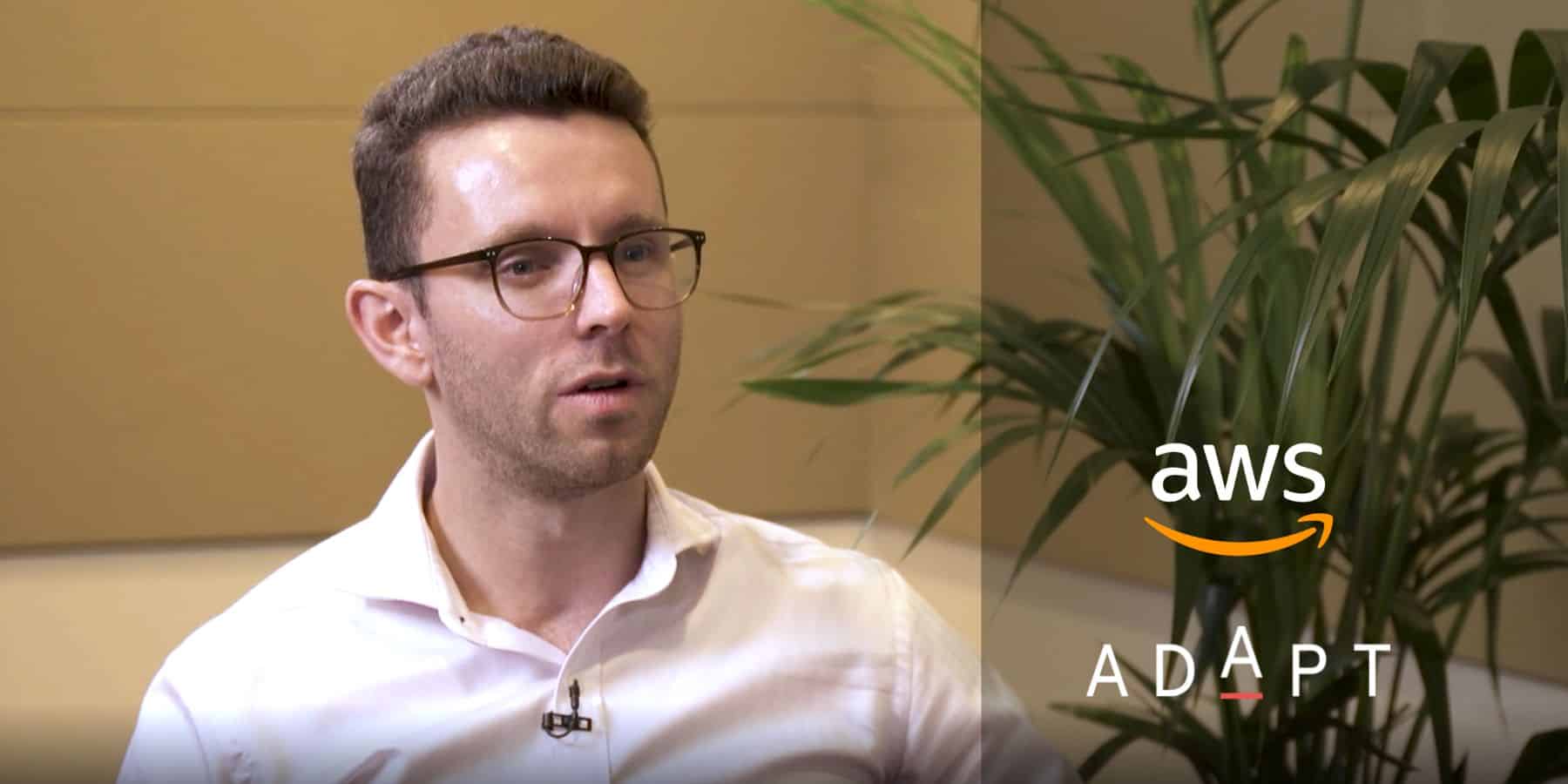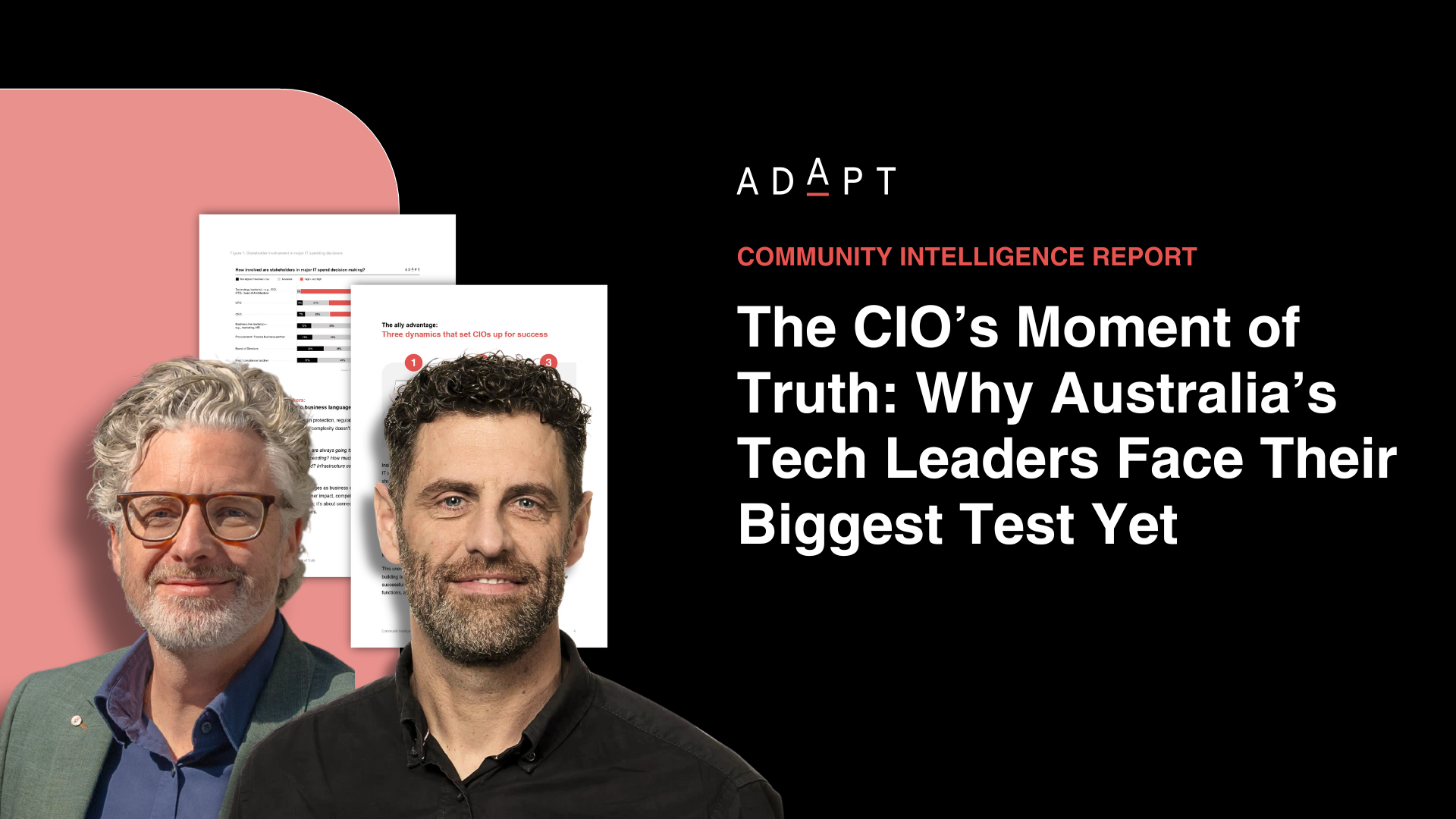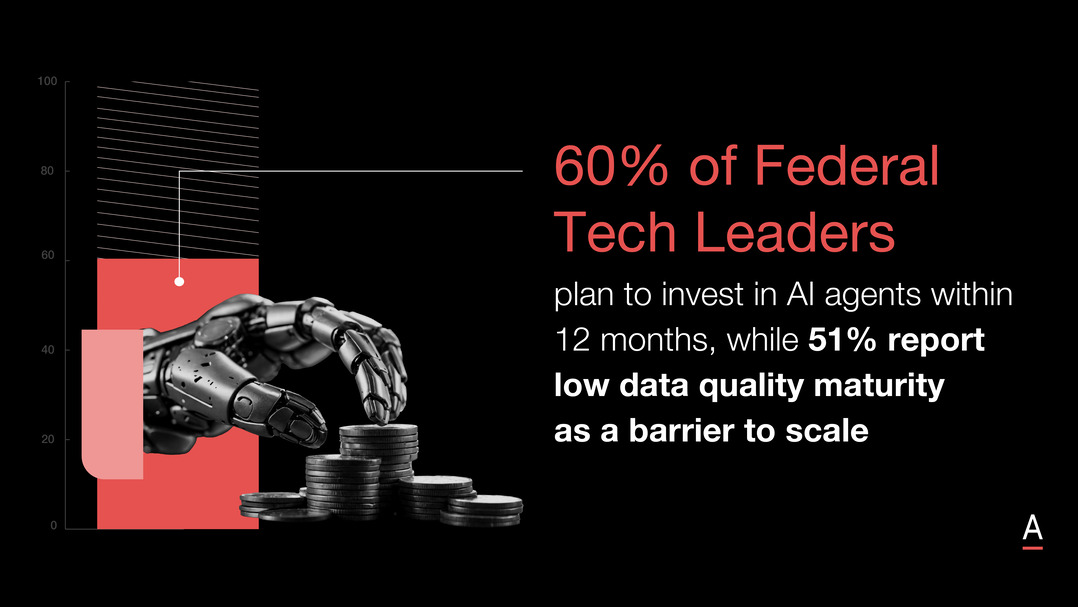5 CIO Priorities for 2025: IT Modernisation, AI, and Business Value
ADAPT's research reveals 5 key trends in CIO priorities in 2025: prioritising IT modernisation, AI integration, and measurable value to drive business transformation.
As Australian organisations navigate economic uncertainty and rapid technological change, CIOs are under pressure to drive efficiency while enabling business innovation.
ADAPT’s 2024 CIO Edge research, based on insights from over 140 ANZ CIOs, reveals five critical shifts that are reshaping IT leadership.
These priorities reflect a broader need to simplify operations, integrate AI, modernise legacy systems, and establish IT as a key driver of business value.
Heading into 2025, CIOs must refine their strategies to ensure technology investments contribute to long-term competitiveness.
1. From complexity to simplification & execution
CIOs are moving beyond foundational IT concerns like cyber security and cloud adoption to focus on operational excellence, modernisation, and cost efficiency.
Security, once a top CIO priority, has dropped from the second to the eighth position in ADAPT’s rankings, indicating that leaders now see it as a baseline rather than a differentiator.
Instead, CIOs are turning their attention to digitisation, automation, and revenue-generating initiatives.
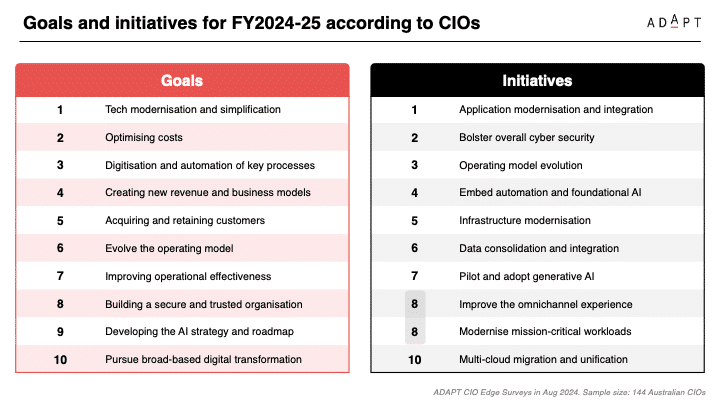
However, this shift is hindered by legacy systems, fragmented IT ecosystems, and the operational burden of maintaining outdated infrastructure.
Australia Post illustrates this shift in action.
Faced with rising operational costs and a need for greater agility, the organisation undertook a major IT modernisation effort.
By migrating to cloud-based solutions and retiring legacy systems, it achieved A$140.8M in efficiencies while driving a 1.3% revenue increase to A$3.86B.
This transformation highlights the importance of disciplined cost management and a streamlined IT environment in enabling CIOs to focus on strategic growth.
Recommended actions
To achieve similar outcomes, CIOs must:
- Streamline legacy systems by assessing technical debt and prioritising system modernisation to improve agility and security.
- Leverage automation & AI to reduce manual processes, accelerate execution, and free IT teams to focus on strategic initiatives.
- Consolidate tech stacks to reduce complexity, enhance integration, and strengthen security while optimising costs.
By simplifying their IT environments and improving execution capabilities, CIOs can drive efficiency while positioning their organisations for innovation.
2. AI readiness: Overcoming data & governance barriers
AI adoption is accelerating, but readiness remains a significant challenge.
ADAPT’s research shows that while organisational readiness for AI has increased 2.3x since early 2024, 70% of organisations still don’t expect to be fully prepared within the next year.
Many are rushing to integrate AI-powered solutions, yet fundamental issues around data governance, process maturity, and organisational culture are stalling progress.
Without a strong data foundation, AI initiatives risk amplifying inefficiencies rather than delivering strategic value.
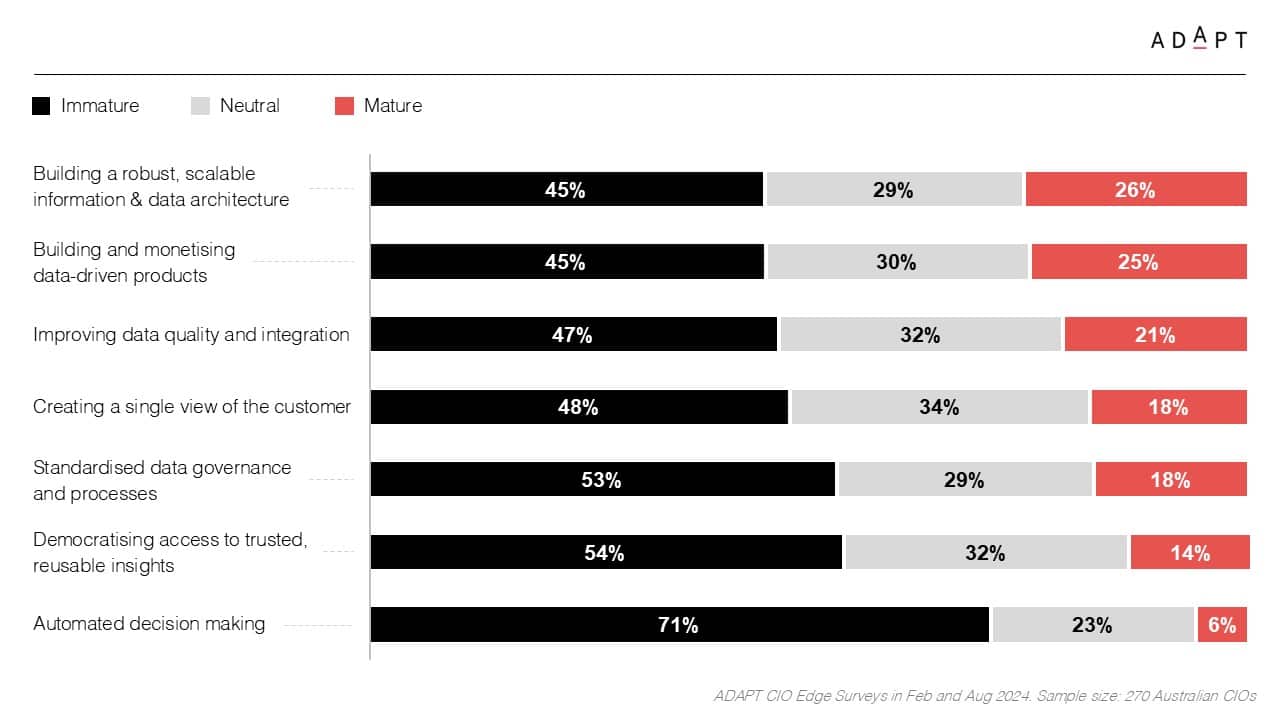
Commonwealth Bank of Australia (CBA) demonstrates a measured approach to AI adoption.
Through its CommBank Gen.ai Studio, the bank is leveraging AI to enhance customer interactions and streamline operations.
With over 50 AI use cases, including real-time personalised services and home loan offerings, CBA has achieved a 66% increase in customer engagement.
Crucially, it has paired AI deployment with extensive employee upskilling, ensuring responsible scaling and long-term value capture.
Recommended actions
For CIOs aiming to accelerate AI maturity, consider these actions:
- Build strong data foundations by establishing governance frameworks, improving data quality, and eliminating silos to support AI scalability.
- Invest in AI literacy across all levels to drive adoption and improve organisational readiness for AI-driven transformation.
- Ensure responsible AI practices with clear ethical guidelines, compliance measures, and privacy controls to mitigate risks.
Without these foundational elements, AI initiatives will struggle to move beyond proof-of-concept stages, limiting their ability to drive meaningful business impact.
3. Balancing IT modernisation with business innovation
Modernisation remains a top CIO priority, but funding constraints and legacy debt are creating significant roadblocks.
ADAPT’s research finds that IT budgets have dropped 58% since 2023, with small and mid-sized enterprises (SMEs) hit hardest, experiencing reductions of over 70%.
With resources stretched thin, CIOs are allocating just 4% of their budgets to innovation, while the bulk is directed towards stabilising core systems.
Yet, leading CIOs are finding ways to modernise while still delivering business value.

Virgin Australia, for instance, has integrated IT within its customer strategy team, breaking down traditional silos between technology and business functions.
This shift has enabled faster innovation cycles, closer alignment between technology investments and customer experience goals, and improved agility in responding to market demands.
Recommended actions
For CIOs striking the right balance:
- Reduce technical debt by prioritising infrastructure modernisation and automating processes to free resources for innovation.
- Strengthen IT-business collaboration by embedding IT within revenue-generating teams to drive closer alignment and strategic impact.
- Leverage partnerships to co-develop solutions that enhance business capabilities while reducing modernisation costs.
By ensuring that modernisation efforts are closely tied to business value, CIOs can secure greater executive buy-in and funding for transformational initiatives.
4. Demonstrating IT’s business value
As CIOs take on more strategic leadership roles, they face increasing pressure to justify IT investments.
Despite significant spending on digital initiatives, many organisations struggle to measure the direct business impact of technology.
ADAPT’s research shows that only 30% of CIOs report success in using technology to reduce overall business costs, and 41% face challenges in delivering integrated omni-channel experiences.
Without clear cost-to-value frameworks, IT remains seen as a cost centre rather than a driver of business transformation.

CIOs in leading organisations are addressing this challenge by embedding cost-to-value metrics into their IT strategies.
Those with transparent frameworks see higher executive buy-in, stronger alignment between IT and corporate goals, and more flexibility in securing funding.
By quantifying the impact of technology investments—whether through cost savings, revenue growth, or operational efficiencies—CIOs can shift the perception of IT from a support function to a strategic enabler.
Recommended actions
To strengthen IT’s value proposition, CIOs should:
- Develop measurable cost-to-value frameworks to articulate IT’s contribution to revenue, efficiency, and competitive advantage.
- Reallocate time for strategic collaboration by increasing engagement with C-suite executives and customer-facing teams.
- Embed AI and automation within business-centric initiatives to enhance productivity and unlock new growth opportunities.
With a clear cost-to-value strategy, CIOs can secure stronger executive support and elevate IT’s role in shaping organisational success.
5. Evolving vendor relationships: From supplier to strategic partner
CIOs are rethinking their approach to vendor relationships, shifting away from transactional engagements toward long-term strategic partnerships.
ADAPT’s data shows that 68% of CIOs plan to consolidate vendor engagements, while those actively pursuing consolidation are aiming for a 20% reduction in the number of suppliers they work with.
This reflects a growing preference for vendors who offer integrated solutions, outcome-based pricing, and deep industry expertise.
In today’s environment, CIOs are prioritising deployment reliability (93%), cost optimisation (87%), and flexible delivery models (83%) when selecting partners.
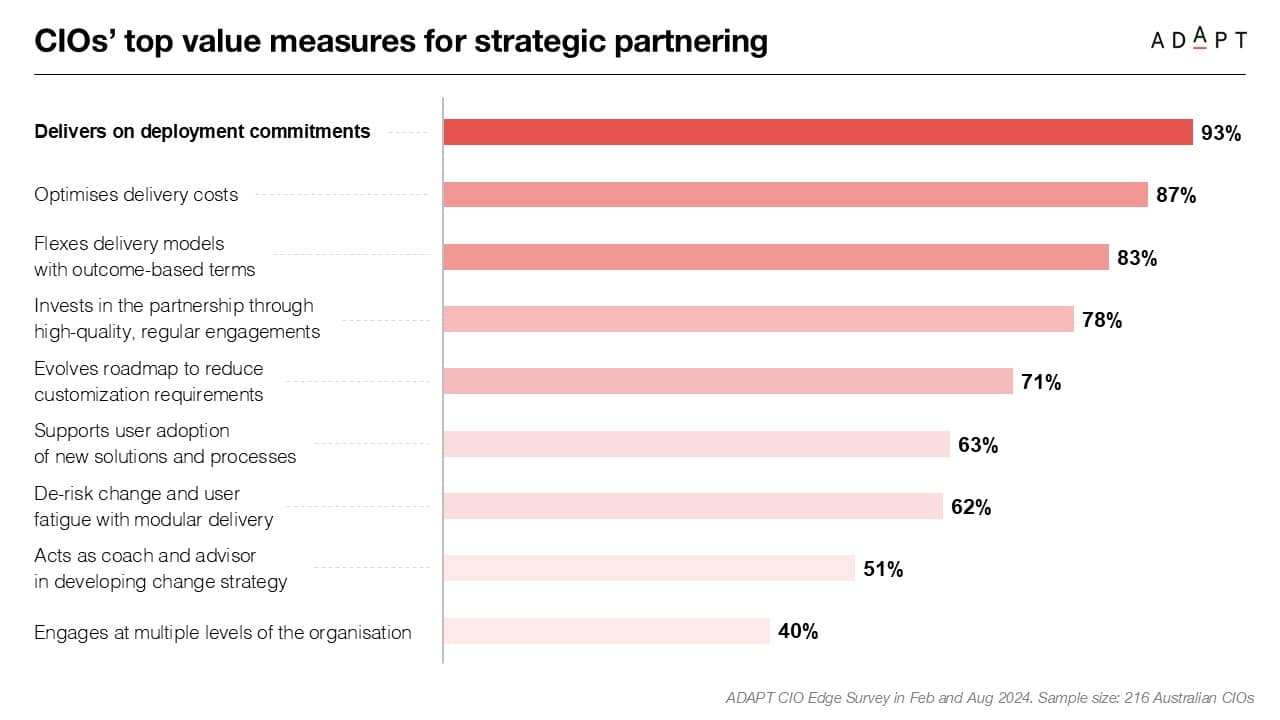
Vendors who can minimise complexity, streamline integrations, and proactively evolve their solutions in alignment with business needs will be best positioned to secure long-term relationships.
Recommended actions
To build stronger vendor partnerships, CIOs should:
- Prioritise strategic vendors who offer end-to-end solutions that reduce integration complexity and drive business outcomes.
- Demand measurable business impact by working with vendors to establish clear success metrics and outcome-based contracts.
- Foster continuous innovation and alignment by engaging in ongoing collaboration and roadmap co-development with key partners.
By shifting from transactional vendor management to strategic partnerships, CIOs can unlock greater value from their technology investments while reducing risk and complexity.
Final thoughts
As CIOs prepare for 2025, their ability to drive business transformation will depend on their success in modernising IT, integrating AI, and demonstrating measurable value.
The shift from complexity to execution, the need for AI readiness, and the push for vendor consolidation all signal a growing emphasis on efficiency, agility, and strategic alignment.
By refining their technology strategies in line with these priorities, CIOs can ensure their IT investments not only sustain operations but actively contribute to business growth and competitive advantage.
Access ADAPT’s full report to gain data-driven insights and more executive actions to help CIOs navigate these shifts and future-proof their IT strategies.




